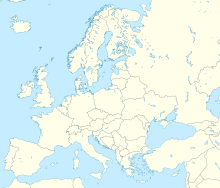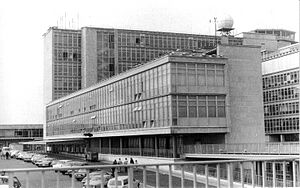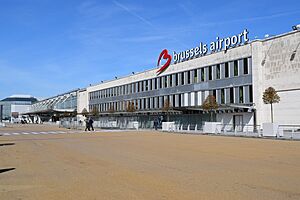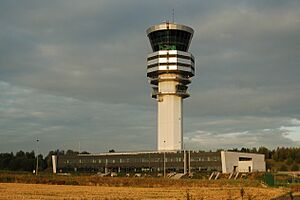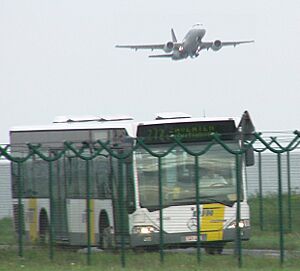Brussels Airport facts for kids
Quick facts for kids
Brussels Airport
|
|||||||||||||||||||
|---|---|---|---|---|---|---|---|---|---|---|---|---|---|---|---|---|---|---|---|
 |
|||||||||||||||||||
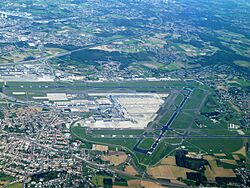 |
|||||||||||||||||||
| Summary | |||||||||||||||||||
| Airport type | Public / Military | ||||||||||||||||||
| Owner/Operator | Brussels Airport Company | ||||||||||||||||||
| Serves | Brussels Capital Region Flemish Brabant Walloon Brabant |
||||||||||||||||||
| Location | Zaventem, Flemish Brabant, Belgium | ||||||||||||||||||
| Hub for |
|
||||||||||||||||||
| Focus city for | TUI fly Belgium | ||||||||||||||||||
| Elevation AMSL | 184 ft / 56 m | ||||||||||||||||||
| Coordinates | 50°54′05″N 004°29′04″E / 50.90139°N 4.48444°E | ||||||||||||||||||
| Website | brusselsairport.be | ||||||||||||||||||
| Maps | |||||||||||||||||||
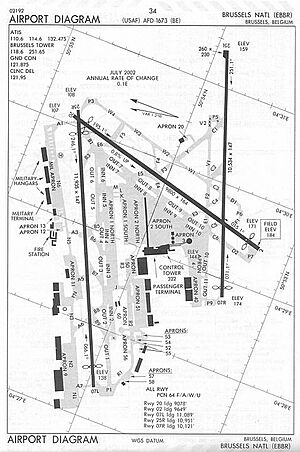 Airport diagram |
|||||||||||||||||||
| Runway | |||||||||||||||||||
|
|||||||||||||||||||
| Statistics (2019) | |||||||||||||||||||
|
|||||||||||||||||||
|
Sources: Brussels Airport, Belgian AIP
|
|||||||||||||||||||
Brussels Airport is a big international airport in Belgium. It is located in a town called Zaventem, which is northeast of Brussels. People also sometimes call it Brussels-National Airport or Brussels-Zaventem Airport.
In 2019, over 26 million passengers used Brussels Airport. This made it the 26th busiest airport in Europe. The airport is a home base for airlines like Brussels Airlines and TUI fly Belgium. It covers a huge area of 1,245 hectares (about 3,076 acres) and has three runways. Many companies operate here, providing jobs for about 20,000 people.
The company that runs the airport is called The Brussels Airport Company. Since 2011, different groups own parts of the airport. These include a Canadian pension plan, a company from Australia, and the Belgian government.
On March 22, 2016, the airport's departures hall was damaged by a sad event. The airport had to close for a while. It reopened on April 3, 2016, with temporary areas for travelers. Since then, the airport has fully recovered and is back to normal operations.
Contents
History of Brussels Airport
How Brussels Airport Started
The story of Brussels Airport in Zaventem began in 1940. During World War II, the German army took over some farmland. They built an airfield there called Fliegerhorst Melsbroek. They made three runways in a triangle shape. Two of these runways are still used today. The airport buildings were in Melsbroek, so locals called it Melsbroek. There's a story that the Germans picked this spot because locals told them it was often foggy there.
After the war, the British took over the airfield. The old civilian airport in Haren became too small. So, Belgian leaders decided to use Melsbroek as the new national airport. By 1948, a new terminal building was built. The runways were made longer. The civil airport of Melsbroek officially opened on July 20, 1948. Many more buildings were added between 1948 and 1956.
In 1955, a train line was built from Brussels city center to the airport. It opened on May 15, 1955.
In 1956, a new runway was built, 07R/25L. It runs almost next to runway 07L/25R. This runway is still used today. In April 1956, the Belgian government decided to build a new airport. It would use the same runways but have new buildings in Zaventem. Construction for the new terminal started in April 1957. This was to get the airport ready for the 1958 World's Fair (Expo 58). The new airport opened on July 5, 1958. The old buildings in Melsbroek are still used by the Belgian Air Force. Both Zaventem Airport and Melsbroek Air Base share the same runways.
Airport Growth Since the 1960s
In the 1960s and 1970s, air travel became very popular. More hangars were built at the airport. A new cargo terminal was added in 1976. In 1994, a brand new terminal was built next to the old 1958 building. Two old piers were taken down and replaced with modern ones. In 2002, a new pier was opened.
In 2005, Brussels Airport was named the Best Airport in Europe. This was based on a survey of over 100,000 passengers. The airport has continued to be ranked among the top airports. A direct train link to Leuven and Liège opened in December 2005.
In 2007, the airport served 17.8 million passengers. This was a 7% increase from 2006. The amount of cargo also grew by almost 9%. In 2008, 18.5 million passengers used the airport.
When the national airline Sabena stopped flying, fewer passengers used the airport. It took some time for the airport to recover. In March 2009, the old flight information screens were replaced with new electronic ones.
2016 Brussels Bombings
On March 22, 2016, two explosions happened at Brussels Airport. This was at 7:58 AM local time. One was near the check-in desks, and another was near a coffee shop. A third bomb was found and safely exploded by experts. The airport was closed until April 3. When it reopened, it could only handle a small number of passengers. Flights meant for Brussels Airport were either canceled or sent to other nearby airports. Later that day, another explosion happened at a metro station in Brussels. A group called ISIL said they were responsible for these events.
Airport Facilities
Brussels Airport has a "one terminal" design. This means all the main parts of the airport are under one roof. The terminal building has several levels. The train station is on level -1. Buses and taxis arrive on level 0. Arrivals are on level 2, and departures are on level 3. Levels 2 and 3 connect to the airport's two main areas, called piers (Pier A and Pier B).
Pier A: Modern Travel Hub
Pier A is the newest part of Brussels Airport. It opened on May 15, 2002. This pier was first built for flights to and from countries in the Schengen Area. These are countries in Europe that have agreed to allow free movement of people. However, since 2008, some flights to Africa also use Pier A. This meant adding border control points at the end of the pier.
Before 2015, Pier A was connected to the main building by a long tunnel. Each pier had its own security check. This meant you had to go through security again if you changed between piers. This tunnel was replaced by a new building called the "Connector." This new building links both piers above ground. Now, passengers can walk straight from check-in to their gate in Pier A or B. Border control is now in the Connector. This makes it easier to transfer between flights without extra security checks.
Pier B: Flights Beyond Schengen
Pier B is the oldest pier still in use at Brussels Airport. It is used only for flights going to countries outside the Schengen Area. Pier B is directly connected to the main departure hall. It has two levels. The upper level (level 3) is for passengers who are departing. The lower level (level 2) is for arriving passengers. This level connects directly to border control and the baggage claim area.
Future Plans for the Airport
Pier A West Expansion
Pier A West is a planned addition to Pier A. It is meant to help Pier B by handling more flights to non-Schengen countries. It was supposed to open in 2016. However, due to slower passenger growth, the airport delayed the work. In 2015, Brussels Airport announced a big investment. This investment includes the expansion of Pier A.
New Low-Cost Pier
Building a new pier for low-cost airlines is also on hold. It will be built where an old pier used to be. Currently, some low-cost airlines fly to Brussels South Charleroi Airport, which is about 40 km (25 miles) from Brussels. In 2013, one low-cost airline moved its flights from Brussels Airport to Charleroi. However, Turkish Airlines started offering flights on the same route. Then, Ryanair announced it would open a second base at Brussels Airport. This brought more low-cost flights to Brussels Airport.
Airport Services for Travelers
Brussels Airport has many services for passengers. You can find drinking water fountains all over the airport. After security, you can buy water bottles for a small fee.
There are many shops, bars, and restaurants throughout the airport. Some are in the departure area, like convenience stores and coffee shops. Most shops are after security control and offer tax-free shopping. Many popular brands have stores in both piers.
The airport also has places for worship for different religions. There is also a quiet place for meditation. For business travelers, the airport offers meeting rooms. You can also find the Sheraton Brussels Airport Hotel right across from the terminal. Other nearby hotels offer shuttle services.
All passengers can enjoy free Wi-Fi access at the airport.
Other Important Facilities
Many airlines have their main offices at Brussels Airport. For example, Brussels Airlines has its main office in a building called b.house. Other airlines, like European Air Transport and the former Sabena, also had their offices here.
Airlines and Destinations
Passenger Flights
Many airlines fly regularly to and from Brussels Airport. These include scheduled flights and charter flights. Here are some of the airlines and places they fly to:
| Airlines | Destinations |
|---|---|
| Aegean Airlines | Athens, Thessaloniki |
| Aer Lingus | Dublin |
| Air Algérie | Algiers Seasonal: Oran |
| Air Arabia | Casablanca, Fès, Nador, Oujda, Rabat, Tangier, Tétouan |
| airBaltic | Riga, Tallinn |
| Air Canada | Montréal–Trudeau Seasonal: Toronto–Pearson |
| Air Europa | Madrid |
| Air Serbia | Belgrade |
| Air Transat | Seasonal: Montréal–Trudeau |
| AJet | Istanbul–Sabiha Gökçen Seasonal: Ankara |
| All Nippon Airways | Tokyo–Narita |
| Amelia International | Brive |
| Austrian Airlines | Vienna |
| BH Air | Seasonal: Burgas |
| British Airways | London–Heathrow |
| Brussels Airlines | Abidjan, Accra, Alicante, Athens, Banjul, Barcelona, Berlin, Bilbao, Billund, Bologna, Budapest, Bujumbura, Conakry, Copenhagen, Cotonou, Dakar–Diass, Douala, Edinburgh, Entebbe, Faro, Frankfurt, Freetown, Fuerteventura (resumes 27 October 2024), Geneva, Gothenburg, Gran Canaria, Hamburg, Hurghada, Kigali, Kinshasa–N'djili, Kraków, Lanzarote, Lisbon, Ljubljana, Lomé, London–Heathrow, Luanda, Lyon, Madrid, Málaga, Manchester, Marseille, Milan–Linate, Milan–Malpensa, Monrovia–Roberts, Munich, Nairobi–Jomo Kenyatta (resumes 3 June 2024), New York–JFK, Nice, Oslo, Ouagadougou, Paris–Charles de Gaulle, Porto, Prague, Rome–Fiumicino, Stockholm–Arlanda, Tel Aviv, Tenerife–South, Toulouse, Valencia, Venice, Vienna, Vilnius, Warsaw–Chopin, Yaoundé, Yerevan, Zürich Seasonal: Birmingham, Bordeaux, Brindisi, Catania, Chania, Corfu, Djerba, Dubrovnik, Florence, Heraklion, Ibiza, Kos, Marrakesh, Monastir, Mytilene, Nador, Naples, Olbia, Oujda, Palma de Mallorca, Rabat, Rhodes, Samos, Sharm El Sheikh, Split, Tangier, Washington–Dulles, Zadar, Zakynthos Seasonal charter: Harstad/Narvik |
| Bulgaria Air | Sofia |
| Corendon Airlines | Seasonal: Antalya, Bodrum, Burgas, Dalaman, Eskişehir, Heraklion, Izmir, Kos, Palma de Mallorca, Rhodes, Tenerife–South |
| Croatia Airlines | Zagreb |
| Cyprus Airways | Larnaca |
| Dan Air | Bacău |
| Delta Air Lines | Seasonal: New York–JFK |
| easyJet | Geneva, Nice |
| Egyptair | Cairo |
| Emirates | Dubai–International |
| Ethiopian Airlines | Addis Ababa |
| Etihad Airways | Abu Dhabi |
| Finnair | Helsinki |
| Flynas | Jeddah |
| FlyOne | Chișinău |
| Hainan Airlines | Beijing–Capital, Shanghai–Pudong (resumes 18 June 2024), Shenzhen |
| HiSky | Bucharest–Otopeni |
| Iberia | Madrid |
| Icelandair | Reykjavík–Keflavík |
| ITA Airways | Milan–Linate, Rome–Fiumicino |
| Juneyao Airlines | Shanghai–Pudong (begins 1 July 2024) |
| KLM | Amsterdam |
| KM Malta Airlines | Malta |
| LOT Polish Airlines | Warsaw–Chopin |
| Lufthansa | Frankfurt, Munich |
| Middle East Airlines | Beirut |
| Nouvelair | Seasonal: Djerba, Tunis |
| Play | Seasonal: Reykjavík–Keflavík |
| Qatar Airways | Doha |
| Royal Air Maroc | Casablanca, Marrakesh, Nador, Rabat, Tangier Seasonal: Al Hoceima, Oujda |
| Royal Jordanian | Amman–Queen Alia |
| RwandAir | Kigali |
| Ryanair | Barcelona, Berlin, Dublin, Madrid, Málaga, Marrakesh, Porto, Rome–Fiumicino, Valencia Seasonal: Girona, Palma de Mallorca, Pisa |
| Scandinavian Airlines | Copenhagen, Oslo, Stockholm–Arlanda |
| Singapore Airlines | Singapore |
| Sky Express | Athens Seasonal: Heraklion |
| SunExpress | Eskişehir Seasonal: Adana, Ankara, Antalya, Dalaman, Izmir |
| Swiss International Air Lines | Geneva, Zürich |
| TAP Air Portugal | Lisbon |
| TAROM | Bucharest–Otopeni |
| Transavia | Alicante, Bari (begins 27 June 2024), Faro, Marrakesh (begins 27 June 2024), Thessaloniki (begins 28 June 2024) Seasonal: Ibiza, Innsbruck, Málaga, Salzburg, Santorini, Seville, Tenerife–South, Zakynthos |
| TUI fly Belgium | Agadir, Algiers, Al Hoceima, Alicante, Antalya, Béjaïa, Boa Vista, Cancún, Casablanca, Constantine, Curaçao (begins 5 November 2024), Dakar–Diass, Djerba, Enfidha, Eskişehir, Fès, Fuerteventura, Funchal, Gran Canaria, Hurghada, Lanzarote, Málaga, Marrakesh, Marsa Alam, Oran, Oujda, Punta Cana, Rabat, Sal, Sharm El Sheikh, Tenerife–South, Tirana, Tlemcen, Tunis, Varadero Seasonal: Almería, Banjul, Bodrum, Brindisi, Burgas, Catania, Chania, Corfu, Dalaman, Dubrovnik, Faro, Girona, Heraklion, Ibiza, Izmir, Jerez de la Frontera, Kittilä, Kos, Lamezia Terme, Larnaca, Luxor, Menorca, Montego Bay, Mykonos, Mytilene, Nador, Naples, Palermo, Palma de Mallorca, Paphos, Patras, Ponta Delgada, Pristina, Reus, Rhodes, Samos, Santorini, Tangier, Tétouan, Thessaloniki, Tivat, Varna, Zakynthos |
| Tunisair | Tunis |
| Turkish Airlines | Istanbul |
| United Airlines | Chicago–O'Hare, Newark, Washington–Dulles |
| Vueling | Alicante, Barcelona, Málaga, Valencia Seasonal: Bilbao, Seville |
| Widerøe | Bergen |
| Wizz Air | Budapest (begins 19 June 2024) |
Cargo Flights
Cargo airlines also use Brussels Airport to transport goods. Here are some of the cargo airlines and their destinations:
| Airlines | Destinations |
|---|---|
| DHL Aviation | Bahrain, Barcelona, Bergamo, Bratislava, Budapest, Cincinnati, Copenhagen, East Midlands, Oslo, Helsinki, Lagos, Leipzig/Halle, Lisbon, London–Heathrow, Madrid, Miami, Shanghai–Pudong, Seoul–Incheon, Vitoria |
| Egyptair Cargo | Cairo |
| Emirates SkyCargo | Chicago–O'Hare, Columbus–Rickenbacker, Dubai–Al Maktoum |
| Ethiopian Cargo | Addis Ababa, Johannesburg–O.R. Tambo, Miami, Seoul–Incheon |
| LATAM Cargo Chile | Frankfurt, Campinas–Viracopos, Santiago de Chile |
| Qatar Airways Cargo | Accra, Chicago–O'Hare, Doha, Los Angeles |
| Royal Air Maroc Cargo | Casablanca |
| Singapore Airlines Cargo | Mumbai, Singapore, Sharjah |
| Suparna Airlines | Moscow–Domodedovo, Zhengzhou |
| Turkish Cargo | Istanbul |
Airport Statistics
Passenger and Cargo Traffic Over the Years
| Year | Passenger volume | Change over previous year | Aircraft operations | Change over previous year | Cargo (tonnes) | Change over previous year |
|---|---|---|---|---|---|---|
| 2023 | 22,200,755 | 192,257 | 585,203 | |||
| 2022 | 18,930,698 | 178,930 | 621,482 | |||
| 2021 | 9,357,221 | 118,733 | 668,110 | |||
| 2020 | 6,743,395 | 95,813 | 511,613 | |||
| 2019 | 26,360,003 | 234,460 | 500,702 | |||
| 2018 | 25,675,939 | 235,459 | 543,493 | |||
| 2017 | 24,783,911 | 237,888 | 535,634 | |||
| 2016 | 21,818,418 | 223,688 | 494,637 | |||
| 2015 | 23,460,018 | 239,349 | 489,303 | |||
| 2014 | 21,933,190 | 231,528 | 453,954 | |||
| 2013 | 19,133,222 | 216,678 | 429,938 | |||
| 2012 | 18,971,332 | 223,431 | 459,265 | |||
| 2011 | 18,786,034 | 233,758 | 475,124 | |||
| 2010 | 17,180,606 | 225,682 | 476,135 | |||
| 2009 | 16,999,154 | 231,668 | 449,132 | |||
| 2008 | 18,515,730 | 258,795 | 661,143 | |||
| 2007 | 17,900,000 | 264,366 | 783,727 | |||
| 2006 | 16,707,892 | 254,772 | 719,561 | |||
| 2005 | 16,179,733 | 253,255 | 702,819 | |||
| 2004 | 15,632,773 | 254,070 | 664,375 | |||
| 2003 | 15,194,097 | 252,249 | 607,136 | |||
| 2002 | 14,410,555 | 256,889 | 536,826 | |||
| 2001 | 19,684,867 | 305,532 | 583,729 | |||
| 2000 | 21,637,003 | 352,972 | 687,385 | |||
| 1999 | 20,048,532 | 312,892 | 674,837 | – | ||
| 1998 | 18,400,000 | 300,000 | ||||
| 1997 | 15,900,000 | 277,000 | ||||
| 1996 | 13,400,000 | 264,000 | – | |||
| 1995 | 12,500,000 | |||||
| 1994 | 11,200,000 | – | ||||
| 1993 | 10,000,000+ | – | ||||
| 1950 | 240,000+ | – |
- The drop in 2001 and 2002 was due to the September 11 Attacks and the end of the airline Sabena.
- The decrease in cargo in 2008 and 2009 was due to a financial crisis. Also, DHL Aviation moved its operations to another airport. This happened after the Belgian government limited night cargo flights due to noise.
- The lower numbers in 2016 were because of the 2016 Brussels bombings. The airport had to close for 11 days and then reopened with less capacity.
Busiest Routes from Brussels Airport
| Rank | Destination | Airport(s) | Passengers 2018 | Passengers 2017 | Passengers 2016 |
|---|---|---|---|---|---|
| 1 | MAD | 1,009,602 | 966,146 | 763,016 | |
| 2 | BCN | 940,782 | 927,618 | 889,180 | |
| 3 | LIS | 733,920 | 738,243 | 698,131 | |
| 4 | FCO | 720,067 | 719,436 | 713,392 | |
| 5 | LHR | 688,333 | 654,712 | 587,487 | |
| 6 | MXP, LIN | 639,346 | 644,841 | 492,068 | |
| 7 | GVA | 608,377 | 591,857 | 545,230 | |
| 8 | FRA | 589,109 | 549,296 | 467,068 | |
| 9 | AGP | 537,230 | 533,863 | 499,228 | |
| 10 | TXL, SXF | 497,362 | 622,816 | 703,272 |
| Rank | Destination | Airport(s) | Passengers 2018 | Passengers 2017 | Passengers 2016 |
|---|---|---|---|---|---|
| 1 | JFK, EWR | 472,960 | 454,187 | 441,212 | |
| 2 | DXB | 343,452 | 228,001 | 187,049 | |
| 3 | TLV | 287,627 | 295,464 | 267,366 | |
| 4 | IAD | 251,655 | 231,859 | 212,027 | |
| 5 | YUL | 205,282 | 197,550 | 174,843 | |
| 6 | DOH | 172,493 | 169,111 | 156,644 | |
| 7 | AUH | 154,054 | 170,549 | 144,239 | |
| 8 | CMN | 145,218 | 159,188 | 142,294 | |
| 9 | BKK | 142,175 | 125,264 | N/A | |
| 10 | ORD | 139,487 | 131,388 | 92,282 |
Getting To and From the Airport
By Road: Cars, Buses, and Taxis
You can reach Brussels Airport by car using the A201 road. This road connects directly to the Brussels Ring Road. From there, you can easily get to Belgium's main highways. The airport has three car parks with over 10,000 parking spaces. There's also a gas station near the airport exit.
Several car rental companies operate at Brussels Airport. These include Europcar, Hertz, Sixt, and Thrifty. You can also find car-sharing services like DriveNow and Zipcar. Taxi2Share offers a shared taxi service from the airport.
Buses are available from De Lijn to various cities in Flanders. The MIVB/STIB provides bus service into Brussels city center. Hotel shuttles also pick up passengers from the airport. Taxis are always available outside the arrivals hall. Look for taxis with a blue and yellow emblem.
By Rail: Trains to Many Cities
The Airport Railway Station is located under the airport building. It's on level -1. Trains from this station go directly to many cities in Belgium. These include Antwerp, Brussels, Ghent, and Leuven. At least four trains per hour go to Brussels South Railway Station. From there, you can catch international trains like Eurostar and ICE to cities across Europe.
A direct train link to Leuven opened in 2005. A direct link to Antwerp and Mechelen opened in 2012. This was part of a project called Diabolo. To pay for this project, all train passengers to Brussels Airport pay a small extra fee.
Since December 2014, there's a direct train link between Bruges and the airport. There's also an Intercity service to Schiphol and Amsterdam. A new tunnel, the Schuman-Josaphat tunnel, now connects the airport directly to the EU quarter in Brussels. This makes travel time between the airport and the EU quarter only 15 minutes.
By Tram: Future Connections
To help with traffic around Brussels, a project called Brabantnet is underway. It plans to create three new light rail lines. Two of these lines will go to Brussels Airport.
- The Airport Tram will connect Brussels Airport to Brussels-North. It will follow a different path from the current train line.
- The Ring Tram will go around the northern part of the Brussels Ring. It will connect several Brussels suburbs and Vilvoorde to the Airport.
To speed things up, a "Trambus" system started in 2020. This is a type of bus that acts like a tram. It runs between Brussels Airport and a hospital in Jette. This is a temporary step until the full tram line is ready. The Airport Tram will be an extension of existing Brussels tram lines. It will need a large bridge to cross the Brussels Ring into the Airport.
By Bicycle: Eco-Friendly Travel
Brussels Airport has a special path for bikers and walkers. There is also a dedicated area to park bikes. Since 2019, the airport is directly connected to the bicycle freeway between Brussels and Leuven. In 2016, only 1% of employees rode bikes to work. To encourage more biking, the airport started a bicycle leasing program for employees. By 2020, almost 10% of employees signed up for it.
Airport Accidents and Incidents
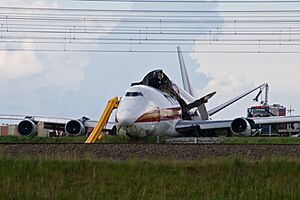
- On September 17, 1946, a Sabena Douglas DC-3 plane crashed during takeoff. One crew member died.
- On February 15, 1961, Sabena Flight 548, a Boeing 707, crashed while landing. All 72 people on board died, along with one person on the ground. This accident sadly killed the entire United States Figure Skating team. They were on their way to a competition. The competition was canceled out of respect.
- On May 25, 2008, Kalitta Air Flight 207, a Boeing 747-200F, went off the end of the runway. It crashed into a field and broke into three pieces. Four of the five people on board had minor injuries.
Images for kids
-
Sabena Boeing 707-300 at Brussels Airport in 1966
-
Air Zaïre McDonnell Douglas DC-10 at Brussels Airport in 1990
See also
 In Spanish: Aeropuerto de Bruselas para niños
In Spanish: Aeropuerto de Bruselas para niños
- Brussels South Charleroi Airport
- Transport in Belgium



